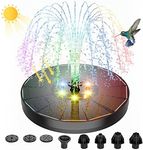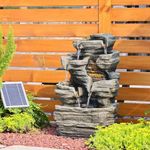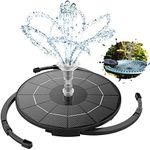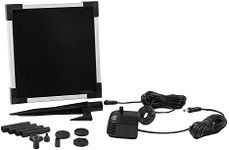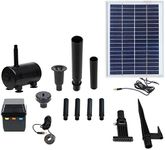Buying Guide for the Best Solar Fountains
Choosing the right solar fountain for your garden or outdoor space can enhance the beauty and tranquility of your environment. Solar fountains are eco-friendly, easy to install, and require minimal maintenance. To make an informed decision, it's important to understand the key specifications and how they align with your needs. Here are the main factors to consider when selecting a solar fountain.Solar Panel TypeThe solar panel is the heart of your solar fountain, as it captures sunlight and converts it into energy to power the pump. There are two main types of solar panels: monocrystalline and polycrystalline. Monocrystalline panels are more efficient and perform better in low-light conditions, making them ideal for areas with less sunlight. Polycrystalline panels are less efficient but more affordable, suitable for regions with abundant sunlight. Choose a solar panel type based on the amount of sunlight your location receives and your efficiency needs.
Pump PowerThe pump power determines the flow rate and height of the water fountain. It is usually measured in gallons per hour (GPH) or liters per hour (LPH). Low-power pumps (up to 100 GPH) are suitable for small fountains and birdbaths, providing a gentle water flow. Medium-power pumps (100-200 GPH) are ideal for medium-sized fountains, offering a moderate water flow. High-power pumps (over 200 GPH) are best for large fountains, creating a strong and impressive water display. Consider the size of your fountain and the desired water flow when selecting the pump power.
Battery BackupA battery backup allows the solar fountain to operate even when there is no direct sunlight, such as during cloudy days or at night. This feature ensures continuous operation and enhances the reliability of the fountain. Fountains with battery backup can store energy during the day and use it when needed. If you want your fountain to run consistently regardless of weather conditions, opt for a model with a battery backup. Otherwise, if you are okay with the fountain operating only during sunny periods, you can choose a model without this feature.
Material and DurabilityThe material of the solar fountain affects its durability, appearance, and maintenance requirements. Common materials include resin, ceramic, metal, and stone. Resin is lightweight, weather-resistant, and easy to maintain, making it a popular choice. Ceramic offers a more decorative and elegant look but may require more care. Metal fountains are durable and can add a modern touch, but they may be prone to rust if not properly treated. Stone fountains are highly durable and provide a natural look but can be heavy and more expensive. Choose a material that matches your aesthetic preferences and maintenance capabilities.
Design and AestheticsThe design and aesthetics of the solar fountain play a significant role in how it complements your outdoor space. Solar fountains come in various styles, including tiered, cascading, birdbath, and contemporary designs. Tiered fountains create a classic and elegant look with multiple levels of water flow. Cascading fountains offer a soothing and natural water flow, ideal for creating a tranquil atmosphere. Birdbath fountains attract birds and add a charming touch to your garden. Contemporary designs feature modern and artistic elements, suitable for a stylish outdoor setting. Consider the overall theme and style of your outdoor space when selecting the design of your solar fountain.
Installation and MaintenanceThe ease of installation and maintenance is an important factor to consider when choosing a solar fountain. Some fountains come as complete kits with everything you need for a quick and easy setup, while others may require additional components or more complex assembly. Maintenance involves cleaning the pump and solar panel regularly to ensure optimal performance. Fountains with removable and washable parts can simplify the maintenance process. If you prefer a hassle-free experience, look for a solar fountain that is easy to install and maintain.
